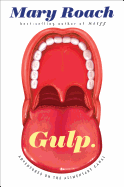
Mary Roach, whose exhaustive research and spirited writing on such subjects as cadavers, sex and the afterlife have made her a go-to expert on "weird science," returns with Gulp: Adventures on the Alimentary Canal, a fascinating albeit sometimes hard to swallow investigation into the human digestive tract. With her signature wit and intrepid reporting on full display, Roach examines every aspect of this important yet squirm-inducing topic, taking readers on a fact-jammed journey that starts at the mouth, winds through the stomach, intestines and colon, and ends with the anus. Addressing the hesitation some readers may feel at embarking on this voyage, Roach states, "I don't want you to say, 'This is gross.' I want you to say, 'I thought this would be gross, but it's really interesting.' Okay, and maybe a little gross." Roach succeeds--and then some--on both counts.
Roach begins her odyssey ("a cruise along the Rhine," she calls it) at the tongue and the complicated interplay of taste and smell. Ever wondered why it is so difficult to describe a smell the same way as, say, a color? Roach explains how we learn to talk by naming what we see and having that name reinforced by adults. When we smell something, however, there is nothing to see and therefore no reinforcement. Taste, however, is a different story. Anyone who has ever been to a wine tasting will appreciate Roach's dismay as she fails to detect the subtleties of almond, artichoke or Band-Aid at a tryout for an olive oil tasting panel. Yet those who could detect the faintest of differences in the olive oils were sometimes stumped by very simple flavors such as almond extract. It turns out that the tongue can be trained and that taste preferences begin even before birth. In her careful but lively examination of saliva (around which are potent taboos), Roach even explains why dunking one's doughnuts is a physiologically sound practice.
As edifying as these earlier anecdotes are, Roach really hits her stride when she reaches the stomach. Here Roach, whose prodigious use of lengthy, humorous footnotes provides a welcome diversion when things get rough, describes the curious relationship between William Beaumont ("the father of American physiology") and Alexis St. Martin upon whom Beaumont performed dozens of experiments in the early 1800s. A duck-shot injury had left St. Martin with a wound that provided a literal window into his stomach. Seeing a once-in-a-lifetime opportunity, Beaumont spent the better part of the next decade dropping various foodstuffs into that stomach and observing how they digested. He also tasted St. Martin's stomach acid. A bit later, Roach moves on to explain the dynamics of this acid and how a stomach can in fact digest itself (though anyone who has suffered from acid reflux will be happy to know that a "healthy adult has a new stomach lining every three days").
Toward the end, Roach reaches what is perhaps the most interesting (and yet horrifying) section of this enlightening book with a thorough examination of what likely caused Elvis' death: not drugs, but constipation. Through careful research and surreal interviews with his infamous doctor, George Nichopoulos, Roach learns that Elvis had suffered from acute constipation his entire life and that his autopsy revealed a colon that was triple the normal size--a "megacolon." Though some of the stories Roach shares here (Nicopoulos packed suitcases full of Fleet enemas to go on tour with Elvis; the King enjoyed his doctor's wife's cooking so much that he had a ring made for her with different colored diamonds representing the components of her Greek hamburgers) fall into the category of bizarrely humorous, Roach does an impressive job of conveying how miserable it must have been for Elvis to live with this condition and by extension, how dangerous it can be. It turns out that constipation, or at least "straining at stool," can kill you. Prolonged straining can set off a chain reaction involving blood pressure and the heart leading to fatal arrhythmia, the official cause of Elvis's death. It is both a sobering and cautionary tale.
Despite such alarming possibilities, however, what emerges most clearly in this fascinating book is the resilience of the human digestive tract. How else to explain the ability of drug mules to transport dozens of cocaine-filled condoms inside their bodies or the practice of "hooping," where prisoners manage to smuggle multiple cell phones inside their rectums without any long-term ill effects? By the end of the book, readers will share Roach's admiration, evident on every page, for this complex system. She clearly relishes the chance to dive into a subject that most writers have avoided and in so doing offers an entertaining and informative (if indeed just a little bit gross) investigation of the human body. --Debra Ginsberg

